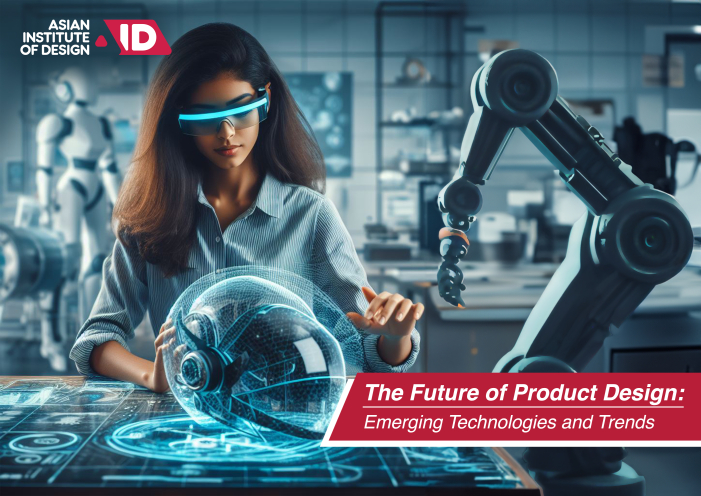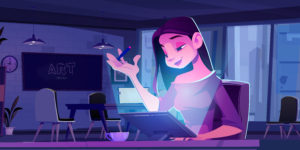The Future of Product Design: Emerging Technologies and Trends

The Future of Product Design: Emerging Technologies and Trends
In the ever-evolving landscape of technology, the field of product design has been significantly impacted by the rapid advances in various domains, from artificial intelligence (AI) to material science. These innovations have not only transformed the way products are conceived and created but have also revolutionized the overall user experience.
As we delve into the future of product design, it is clear that emerging technologies and trends will continue to shape the industry in profound ways, and we, at the Asian Institute of Design are constantly in pursuit to keep up with these evolving trends.
Artificial Intelligence and Machine Learning:
Data-Driven Design: AI and machine learning help designers make data-driven decisions. By analyzing user data, these technologies provide insights into user preferences and behaviors, allowing for more personalized and user-centric product designs.
Automated Design: AI-driven design tools can automate certain aspects of the design process, such as generating design concepts, suggesting improvements, and optimizing designs based on predefined goals.
Reduced Design Cycles: By automating time-consuming tasks, AI can significantly reduce design cycles, leading to faster product development.
Generative Design:
Optimized Product Performance: Generative design takes into account various design parameters, like material properties and manufacturing constraints, to optimize the performance of products. This can lead to more efficient, lightweight, and cost-effective designs. Innovative Structures: Generative design often produces complex, organic-looking structures that were previously difficult to achieve through traditional design methods.
Augmented and Virtual Reality:
Immersive Prototyping: AR and VR enable designers to create and interact with 3D models in immersive environments, allowing for better visualization and understanding of the final product.
Collaborative Design: Virtual environments facilitate collaborative design sessions, with team members from different locations working on a product’s virtual prototype simultaneously.
User Experience Testing: AR and VR are increasingly used for user experience testing, providing valuable feedback during the design phase.
Additive Manufacturing (3D Printing):
Rapid Prototyping: 3D printing accelerates the prototyping process, allowing designers to quickly iterate and test their ideas.
Complex Geometries: 3D printing can create intricate and complex geometries that were previously impossible or cost-prohibitive to manufacture.
Customization: 3D printing enables mass customization, allowing products to be tailored to individual preferences.
Sustainable Design:
Eco-Friendly Materials: Designers are increasingly turning to sustainable and eco-friendly materials, such as recycled plastics, biodegradable compounds, and renewable resources.
Energy Efficiency: Products are being designed to consume less energy, contributing to a greener future by reducing the carbon footprint.
Circular Design: The concept of a circular economy is influencing product design, promoting repairability, recyclability, and reduced waste.
Biodesign and Biomimicry:
Nature-Inspired Solutions: Biomimicry involves emulating nature’s designs and processes, resulting in products that are both efficient and sustainable.
Bioengineered Materials: Advancements in bioengineering are giving rise to innovative materials, such as mycelium-based packaging and spider silk-inspired textiles.
Internet of Things (IoT):
Connected Products: IoT is enabling everyday objects to connect to the internet, providing users with enhanced functionality and remote control.
Data-Driven Insights: IoT devices generate data that can be used to improve product design, making products more responsive to user needs.
Smart Home Integration: IoT is a key driver behind the development of smart home products, from thermostats to security systems.
User-Centered Design:
User Research: Designers are increasingly investing in user research to gain a deeper understanding of user needs, behaviors, and pain points.
Usability Testing: Regular usability testing helps ensure that products are intuitive and meet the expectations of the end-users.
Iterative Design: The iterative design process, guided by user feedback, leads to products that are more user-friendly and effective.
Collaborative Design Tools:
Real-Time Collaboration: Cloud-based design platforms allow teams to collaborate in real-time, making it easier for remote teams to work together.
Version Control: Collaborative tools often include version control features, ensuring that the team works on the latest design iterations.
Integrated Feedback: Many of these tools integrate feedback mechanisms, simplifying the communication between team members and stakeholders.
Customization and Personalization:
Tailored Products: Advances in technology, particularly AI, enable companies to offer personalized products, from shoes to technology devices.
Mass Customization: The line between mass production and customization is blurring, with products being produced on-demand and tailored to individual preferences.
Enhanced Customer Engagement: Customization not only meets user preferences but also enhances the emotional connection between the user and the product.
The future of product designers is an exciting one, driven by these emerging technologies and trends. As we continue to embrace these innovations, products will become more sustainable, user-friendly, and technologically sophisticated. The convergence of these technologies will likely blur the lines between physical and digital design, leading to a new era of product creation that is both imaginative and functional. The world of product design is on the cusp of a transformative era, where technology and innovation are shaping the industry in unprecedented ways.
If you want to get into this world of creativity & innovation, then an Advanced Diploma in Product Design is the right course for you.
Designers, engineers, and creative minds are embracing these emerging technologies to create products that are not only beautiful but also more functional, efficient, and sustainable.
Learning these courses in a big city can be a truly transformative experience that ignites your creativity & transforms your future career choices.
The Future of Product Design courses in Bangalore is limitless, and it holds the promise of enhancing our lives in ways we can only begin to imagine.
Similar Articles
-

Mastering 2D and 3D Animation 03-04-2025
The Ultimate Career Boost in Today’s Creative Industry The demand fo
-

How to Make a Graphic Design Portfolio? 02-27-2025
Imagine walking into a room full of potential clients or employers, bu
-

What are the 12 Principles of Animation? 02-27-2025
Animation is more than just moving images—it’s the art of brea
-

The Changing Face of the Animation Industry 02-27-2025
The animation industry has undergone a seismic transformation over the
